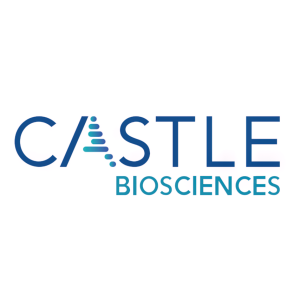Data Published in Ocular Oncology and Pathology Demonstrates Highly Accurate Performance of DecisionDx®-UMSeq for Patients with Uveal Melanoma
DecisionDx-UMSeq identified somatic mutations relevant to uveal melanoma and is indicated as a complement to DecisionDx®-UM and DecisionDx®-PRAME, using the same biopsy tissue
DecisionDx-UMSeq is Castle’s 7-gene test that uses next-generation sequencing (NGS) to identify somatic mutations relevant to uveal melanoma. The sequencing panel identifies hotspot mutations in the genes GNAQ, GNA11, CYSLTR2, PLCB4 and SF3B1, mutations in exons 1-2 of EIF1AX and mutations across all coding exons of the BAP1 gene. This information, together with results from the DecisionDx-UM gene expression profile (GEP) test, is designed to help build a comprehensive genomic profile of an individual UM tumor from a single biopsy, which can then be used to inform patient care. DecisionDx-UM is Castle’s 15-GEP test that uses an individual patient’s tumor biology to predict individual risk of metastasis. DecisionDx-UM is the standard of care in the management of newly diagnosed UM in the majority of ocular oncology practices in
The study titled, “Analytical validation and performance of a 7-gene next-generation sequencing panel in uveal melanoma,” was recently published in the peer-reviewed journal Ocular Oncology and Pathology. The study, which can be viewed here, was designed to evaluate the analytical performance of the DecisionDx-UMSeq panel, which can be run from the same fine needle aspiration biopsy (FNAB) or formalin-fixed paraffin-embedded (FFPE) biopsy sample that is used to run the DecisionDx-UM test.
“The study results demonstrated that running the DecisionDx-UMSeq panel in combination with DecisionDx-UM and DecisionDx-PRAME produced highly accurate results using only a single biopsy sample,” said
Study background and highlights:
- 105 primary tumors were analyzed, including 37 FFPE and 68 FNAB specimens.
-
DecisionDx-UMSeq achieved a positive percent agreement (PPA) of
100% for detection of both single nucleotide variants (SNVs) and insertions/deletions (INDELs), with a technical positive prediction value (TPPV) of98.8% and100% , respectively. - The DecisionDx-UMSeq panel is unique compared to other sequencing panels in that it can be performed from the same biopsy sample that is used to perform the DecisionDx-UM and DecisionDx-PRAME tests and does not require a second biopsy.
- Overall, the study data demonstrated that the combined application of DecisionDx-UM, DecisionDx-PRAME and DecisionDx-UMSeq allowed for highly accurate analysis of both RNA and DNA from a single biopsy sample. The ability to perform mutational profiling of UM tumors, in addition to the DecisionDx-UM test, is an important advance that may aid in confirming the presence of a melanocytic lesion, potentially better inform therapy selection, and provide additional layers of prognostic information to help guide patient care.
About DecisionDx-UMSeq
DecisionDx®-UMSeq is Castle’s 7-gene DNA sequencing panel that uses NGS to identify somatic mutations relevant to uveal melanoma. The sequencing panel identifies hotspot mutations in the genes GNAQ, GNA11, CYSLTR2, PLCB4 and SF3B1, mutations in exons 1-2 of EIF1AX, and mutations across all coding exons of the BAP1 gene. This information, together with results from the DecisionDx®-UM and DecisionDx®-PRAME GEP tests, is designed to help build a comprehensive genomic profile of an individual UM tumor from a single biopsy, which can then be used to inform patient care. The DecisionDx-UMSeq DNA sequencing panel is not intended as a substitute for the DecisionDx-UM GEP test. The DecisionDx-UM GEP test is the only uveal melanoma prognostic method that has been prospectively validated in multiple studies, providing the most robust prognostic information currently available for newly diagnosed UM patients to date.
About DecisionDx-UM
DecisionDx®-UM is a 15-gene GEP test that uses an individual patient’s tumor biology to predict individual risk of metastasis. DecisionDx-UM is the standard of care in the management of newly diagnosed UM in the majority of ocular oncology practices in
It is estimated that nearly 8 in 10 patients diagnosed with UM in the
About DecisionDx-PRAME
DecisionDx®-PRAME is a gene expression profile test that can be run on the same sample used to run DecisionDx®-UM to assess expression of the PRAME gene. PRAME, or preferentially expressed antigen in melanoma, is usually not expressed in normal adult tissues, but in some cancers, PRAME expression is elevated. Elevated expression of PRAME has been associated with an increased risk of metastasis in patients with uveal melanoma.
When used in conjunction with results from the DecisionDx-UM test, PRAME expression status may add further precision to the predicted risk of metastasis and help guide physicians and patients to the most appropriate follow-up care regimens.
More information about the tests and disease can be found at www.CastleTestInfo.com.
About
Castle’s current portfolio consists of tests for skin cancers, uveal melanoma and Barrett’s esophagus. Additionally, the Company has active research and development programs for tests in other diseases with high clinical need, including its test in development to predict systemic therapy response in patients with moderate-to-severe psoriasis, atopic dermatitis and related conditions. To learn more, please visit www.CastleBiosciences.com and connect with us on LinkedIn, Facebook, Twitter and Instagram.
DecisionDx-Melanoma, DecisionDx-CMSeq, DecisionDx-SCC, myPath Melanoma, DecisionDx DiffDx-Melanoma, DecisionDx-UM, DecisionDx-PRAME, DecisionDx-UMSeq and TissueCypher are trademarks of
Forward-Looking Statements
The information in this press release contains forward-looking statements and information within the meaning of Section 27A of the Securities Act of 1933, as amended, and Section 21E of the Securities Exchange Act of 1934, as amended, which are subject to the “safe harbor” created by those sections. These forward-looking statements include, but are not limited to, statements concerning DecisionDx-UMSeq’s ability to identify somatic mutations relevant to uveal melanoma, DecisionDx-UM’s ability to predict individual risk of metastasis, and the combined application of DecisionDx-UM, DecisionDx-PRAME and DecisionDx-UMSeq to aid in confirming the presence of a melanocytic lesion, better inform therapy selection, and provide additional layers of prognostic information to help guide patient care. The words “anticipates,” “believes,” “estimates,” “expects,” “intends,” “may,” “plans,” “projects,” “will,” “would” and similar expressions are intended to identify forward-looking statements, although not all forward-looking statements contain these identifying words. We may not actually achieve the plans, intentions or expectations disclosed in our forward-looking statements, and you should not place undue reliance on our forward-looking statements. Actual results or events could differ materially from the plans, intentions and expectations disclosed in the forward-looking statements that we make. These forward-looking statements involve risks and uncertainties that could cause our actual results to differ materially from those in the forward-looking statements, including, without limitation, the effects of the COVID-19 pandemic on our business and our efforts to address its impact on our business, subsequent study results and findings that contradict earlier study results and findings, DecisionDx-UMSeq’s and DecisionDx-UM’s ability to provide the aforementioned benefits to patients and the risks set forth in our Quarterly Report on Form 10-Q for the quarter ended
View source version on businesswire.com: https://www.businesswire.com/news/home/20220112005096/en/
Investor Contact:
czuckero@castlebiosciences.com
Media Contact:
amarshall@castlebiosciences.com
Source:







